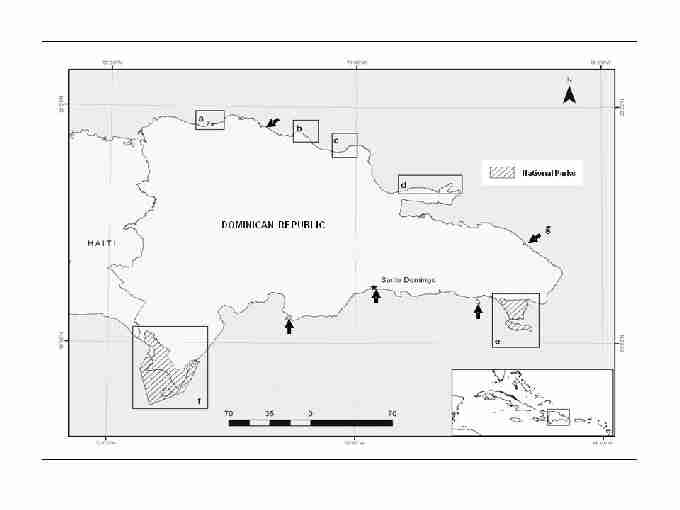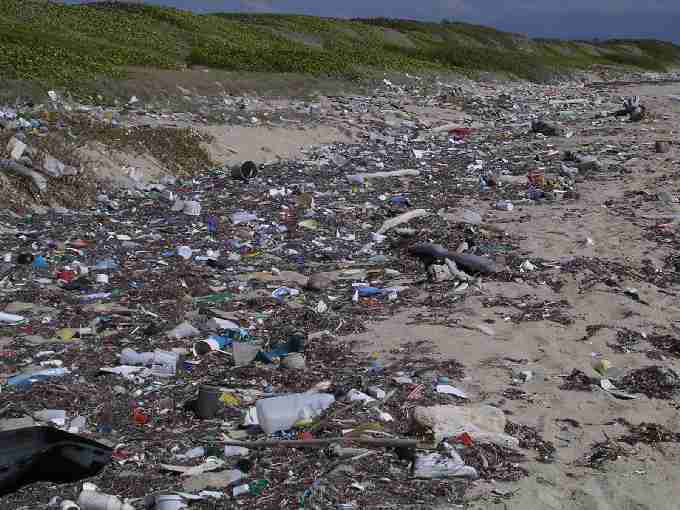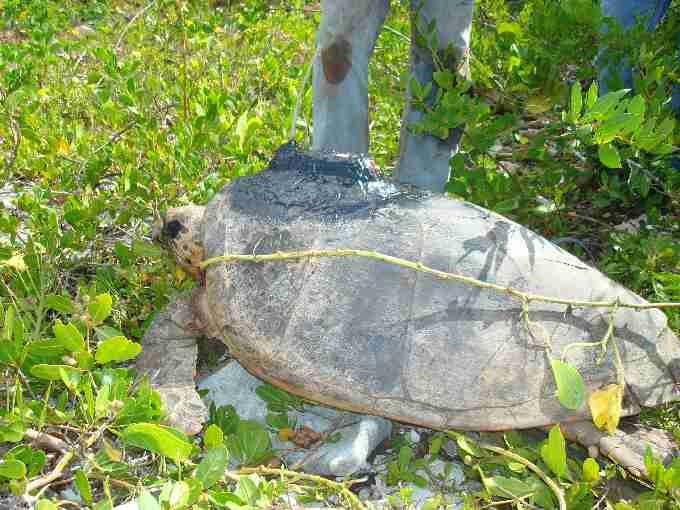J. Tomás1,2, B.J. Godley2, Y.M. León3,4, O. Revuelta1 and J.A. Raga1
1 Cavanilles Institute of Biodiversity and Evolutionary Biology, University of Valencia. P.O. Box 22085, E-46071 Valencia, Spain.
2 Centre for Ecology and Conservation, University of Exeter, Cornwall Campus,Penryn, TR10 9EZ, UK.
3 Grupo Jaragua, El Vergel 33, El Vergel, Santo Domingo, Dominican Republic.
4 Instituto Tecnológico de Santo Domingo, Ave. De los Proceres, Urb. Galá, Santo Domingo, Dominican Republic.
Email: jesus.tomas{at}uv.es
Introduction
Sea turtle nesting in the Caribbean has experienced massive reductions due mainly to human exploitation (McClenachan et al., 2006). Prior to the current project, the last major monitoring efforts in the Dominican Republic (DR) were carried out some two decades ago, focussing on the south-west region (Jaragua National Park) (Ottenwalder, 1981; Ross & Ottenwalder, 1983; Ottenwalder, 1987). According to these studies, four sea turtle species nested on beaches of DR: the hawksbill (Eretmochelys imbricata), the leatherback (Dermochelys coriacea), the green (Chelonia mydas) and the loggerhead turtle (Caretta caretta). Recently, the last two species were considered extirpated, although high densities of green turtle juveniles have been reported from feeding grounds off the south coast. Moreover, the Jaragua National Park (south-west DR) has been proposed as one of the most important aggregations for juvenile hawksbills in the world (Leon & Díez, 1999; Leon & Bjorndal, 2002).
Despite the existence, since 1962, of Dominican laws for the protection of sea turtles, hawksbills are captured frequently for the use of meat and carapace for the tortoiseshell trade (Reuter & Allan, 2006). In 2000, the General Law of Environment and Natural Resources was gazetted. This included specific articles for sea turtle protection including prohibiting egg take and capture of juveniles and adult turtles. However, implementation of this law is very difficult in some areas due to funding and logistics, and illegal take of eggs and captures at sea are frequent. Moreover, beach tourism has experienced a spectacular development in the country over the last decade,
leading to building development in coastal areas and degradation of many
past nesting beaches. These threats together mandate urgent action to
promote the conservation of sea turtles in the DR.
The project
Since 2006, a team of Dominican and European biologists have been carrying out an assessment of marine turtle nesting throughout the DR (Fig. 1). Surveys have been carried out at known nesting sites and are supplemented with data from extensive surveys and interviews throughout the northern and eastern coasts of the country. The project includes training of local people and public awareness in an attempt to ensure long-term data-gathering and conservation legacy. Moreover, possibilities for development of ecotourism have been explored to generate alternative income sources to help prevent direct exploitation of these species.

Fig. 1. Map of the Dominican Republic indicating places where surveys and interviews have been undertaken; a-d: beaches visited with interviews performed and sporadic nesting recorded; e: del Este National Park with Saona island; f: Jaragua National Park; g: Del Muerto beach. Black arrows indicate other records of low level of sea turtle nesting activity communicated by others and/or occasionally visited by members of the project team and collaborators.
Areas studied
Two main nesting sites were detected: The Jaragua National Reserve (JNP, south-west DR) and Saona Island at the East National Park (SI-ENP, south-east DR). The Jaragua National Park, created in 1983, covers 1374km², of which 905km² correspond to the marine and coastal area, mostly composed of beaches and mangroves. No important human settlements are present inside the Park, although a few communities with a population close to 1500 people are settled at its boundaries. However, the Park receives visits from itinerant fishermen from other parts of DR and nearby Haiti. In addition, the eastern beaches of the park are patrolled by beachcombers from local communities and from farther afield. Four beaches were patrolled regularly, two at the west side of the Park: Cabo Rojo and Bahia de las Aguilas, and two at the east side: Mosquea and San Luis (Fig. 1). The rest of the beaches of the Park were periodically patrolled and information from fishermen was collected to record all nesting events occurring. The western beaches are low energy with pristine white sand, clean and free of litter. Bahia de las Aguilas, although undeveloped, receives visits from tourists, mostly Dominicans, particularly during weekends and holidays. Eastern beaches are very high energy shores which contributes to the accumulation of massive amounts of plastic and other debris (Fig. 2).

Fig. 2. View of Mosquea beach (east JNP), an important nesting area for leatherbacks.
Saona Island (18°07’N 68°44’W) has two permanent human settlements with a total population of no more than 400 inhabitants, although the island is visited by fishermen from other regions of the country. The main nesting areas for hawksbills cover 15km of coastline at the south and south-west of the island, including 12 narrow fine grained coralline, white sand beaches interspersed with rocky areas. All beaches are backed by dense forest or palm plantations and access to some beaches by foot is difficult and must be done by boat, complicating the logistics of the project.
Data collection
All beaches of two main nesting areas (JNP and Saona) are surveyed at least weekly, although survey frequency, including nightly surveys, increases when chances to encounter turtles nesting on beaches are high, according to internesting intervals. Surveys are made by the research team, in collaboration with Ministry of the Environment rangers and local and international volunteers and students. During surveys, nests and false crawls are counted and position recorded by GPS, clutch emergences are detected, and data on human and natural predation are collected.
During night patrols all turtles found nesting are flipper tagged and measured. When clutches are at risk of human predation, eggs are collected and transferred to plastic boxes for artificial incubation. Eggs are placed in the boxes imitating natural clutch features and covered by the sand from the original nest. After hatching, hatchlings are taken to the original nesting beach and released to the sea, leaving them to crawl over the sand in case this process is important for natural beach imprinting.
Extensive surveys along the coast of DR have been undertaken to locate sea turtle nesting beaches (Fig. 1). Interviews have been carried out with local people and beach surveys have been undertaken by project researchers.
Population estimates and distribution
The Jaragua Park seems to be the most important area for leatherbacks, despite showing significant differences between years (12 clutches in 2006 vs. 217 in 2009). These numbers would suggest 3-32 leatherback nesting females per year. Hawksbill turtle nesting has been recorded at JNP, but in very low numbers: 4-18 nests resulting in 3-6 nesting females per season. Only one green turtle nest was recorded in JNP during the study.
Saona (ENP) appears as the most important nesting area for hawksbills in the country (62-100 clutches, resulting in about 30 hawksbill nesting females per year). We also recorded sporadic nesting of leatherbacks and green turtles in Saona. This information is crucial, since the latter species was considered extinct as a nester in the country before the present study.
Additional sporadic nesting of leatherbacks and hawksbills occurs throughout the country (Fig. 1) but in very low numbers (estimated at 25 nests per annum, 1-3 nests per beach and year, principally hawksbill nests). Many of these small rookeries face likely extirpation, based on current nest numbers and interviews with local people regarding exploitation patterns. Recently we explored a possible important nesting beach for leatherbacks at the east of the country (‘g’ in Fig. 1), but further research is needed to ascertain its relative importance.
Migratory movements
We also undertook a satellite tracking project to unlock the post nesting migratory movements and target feeding grounds of hawksbill turtles nesting in DR. A total of ten transmitters were placed, eight in the 2008 and two in the 2009 seasons, on females after nesting activities (Fig. 3). To date, at least three of these turtles are still transmitting, and one of them has returned to the nesting rookery after two years in the feeding ground out of the Dominican waters.

Fig. 3. Hawksbill nesting female tagged with a satellite transmitter in Saona in 2009 by the project team.
Tracks of these turtles can be followed through seaturtle.org at these links: www.seaturtle.org/tracking/?project_id=301 and www.seaturtle.org/tracking/?project_id=291.
Threats and conservation
Both the JNP and SI-ENP deserve special attention for conservation of all sea turtle species found as these are the rookeries that extend most hope for the recovery of sea turtle stocks in the country. According to nesting estimations of 30 years ago (Ottenwalder, 1981), these rookeries have experienced a dramatic decrease in numbers of nesting females; thus conservation measures are urgent. Illegal take of eggs and turtle capture for meat and shell at sea and at nesting beaches are the main threats detected currently and probably in the recent past. Illegal egg take is a common activity in JNP and at areas of Saona, where, if no action is taken, nest predation can be close to 100%. Artificial incubation has been carried out by JNP rangers since 1972 to counter this issue. As part of the project, a critical appraisal of ex-situ incubation techniques is under way and community involvement is sought to help reduce egg take. Additionally, lobbying and educational work targets key stakeholders in the tortoiseshell trade. Protection of nesting beaches in National Parks against tourism development, and associated threats, also becomes necessary.
Outlook
It is clear that, although they are not without their problems, the National Parks of the DR have acted as a partial haven for sea turtles. There is much to do to fully elaborate the status at these important rookeries and fully ascertain the relative importance of the other remnants of nesting around the countries.
Acknowledgements
Funding for the project has been from a number of sources: the Spanish International Cooperation Agency (AECI-MAE), the British Chelonia Group, the European Union (Marie Curie grants, FP6 & 7), the General Foundation of the University of Valencia, the Spanish Ministry of Education and Sciences, The Nature Conservancy and The World Wildlife Fund (WWF). The project counts on the support of the Dominican Environmental authorities (office of Protected Areas and Biodiversity of the Environmental Ministry) and the rangers of the National Parks that include sea turtle nesting beaches. Last but not least, the research team wants to extend thanks to the Dominican and international students, volunteers and local villagers who helped in different tasks of the project, particularly as field assistants in beach patrols in the last five years. We especially appreciate the help of Pablo Feliz, Bienvenido Pérez Turbí, Pelagio Paulino, Erin Leline, Sara Arce, Andy Mason, Kate Poulton and Stefania Savore.
References
Feliz, P., León, Y.M., Tomás, J., Hierro, K.E., Mateo, A., Méndez, M.D. & Raga, J.A. (2010). Tortoiseshell trade in Santo Domingo, Dominican Republic: Discouraging news for Caribbean hawksbills. In: Dean, K. & López-Castro, M.C. (compilers). Proceedings of the Twenty-eighth Annual Symposium on Sea Turtle Biology and Conservation. NOAA Tech. Memo. NOAA NMFS-SEFCS-602, pp. 247-248.
León, Y.M. & Diéz, C.E. (1999). Population structure of hawksbill turtles on a foraging ground in the Dominican Republic. Chelonian Conservation and Biology 3(2): 230-236.
León, Y.M. & Bjorndal, K.A. (2002). Selective feeding in the hawksbill turtle, an important predator in coral reef ecosystems. Marine Ecology Progress Series 245: 249-258.
McClenachan, L., Jackson, J. & Newman, M. (2006). Conservation implications of historic sea turtles nesting beach loss. Frontiers in Ecology and the Environment 4: 290-296.
Ottenwalder, J.A. (1981). Status, estimados de población y biología reproductiva de las tortugas marinas en la República Dominicana, Tesis de Licenciatura, Universidad Autónoma de Santo Domingo, Rep. Dominicana.
Ottenwalder, J.A. (1987). Population status, exploitation and management of sea turtles in the Dominican Republic, National report for the Country of Dominican Republic, Western Atlantic Turtle Symposium (WATS II) under contract with Sea Grant Program and the University of Puerto Rico. 52 pp.
Reuter, A. & Allan, C. (2006). Tourists, Turtles and Trinkets: a look at the trade in marine turtle products in the Dominican Republic and Colombia. TRAFFIC. 12 pp.
Ross, J.P. & Ottenwalder, J.A. (1983). The leatherback turtle, Dermochelys coriacea, nesting in the Dominican Republic. Advances in Herpetology and Evolutionary Biology, Cambridge, MA, Museum of Comparative Zoology Harvard, pp. 706-713.
Testudo Volume Seven Number Three.
Top



